October 21, 2023 Trains, Toilets, Tasman Sea (Day 24)
We started the day off watching the Rugby World Cup Semifinals, NZ All Blacks vs. Argentina Pumas, at 8am. By 9:30 when we left the house, NZ was at 34 vs. Argentina 6. We found a radio station and listened for the next half hour as we drove to Kawakawa to catch a train. We arrived before the game ended, but heard later that NZ scored another 10 points! The All Blacks head to the finals vs. either England or South Africa! This weekend happens to be NZ’s ‘Labour Weekend’ (we call it Labor Day). Our Labor Day is the symbolic end of summer, their Labour Weekend is their symbolic beginning of summer! As such, lots of activities are happening over the weekend. We opted for the Vintage Railway train ride, with the steam engine pulling the 4 rail cars!
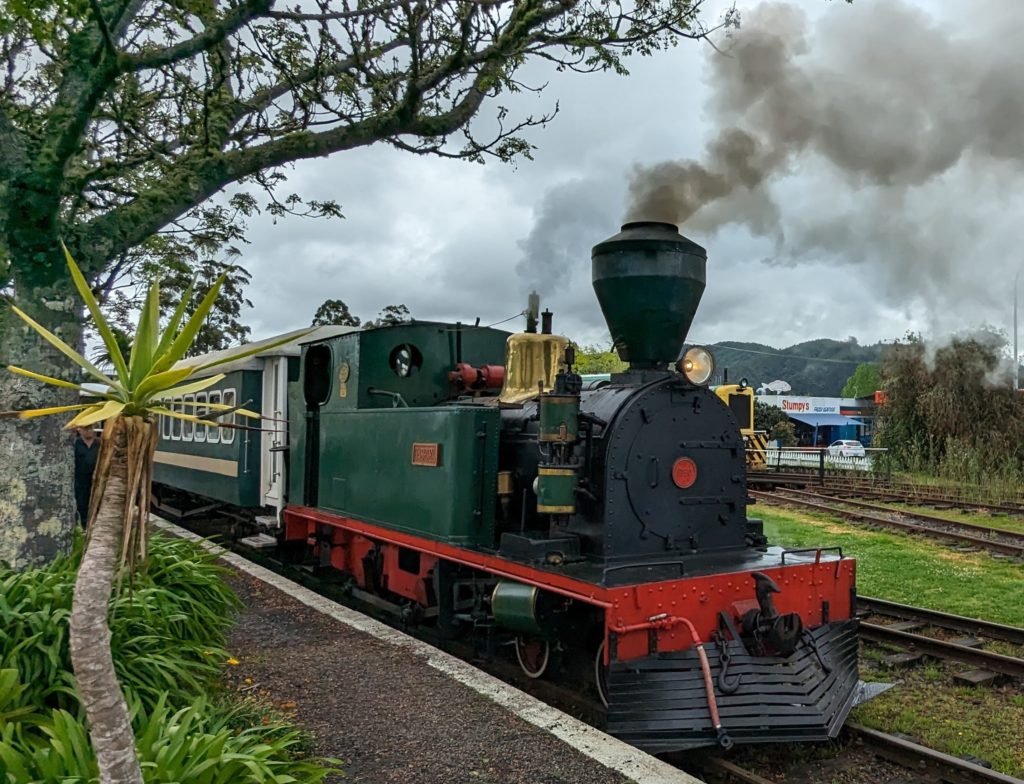
The engine was fired up and ready to go!
We had a great time riding the rails to Taumarere, crossing “over the Long Bridge, the longest curved wooden bridge in the Southern Hemisphere”.
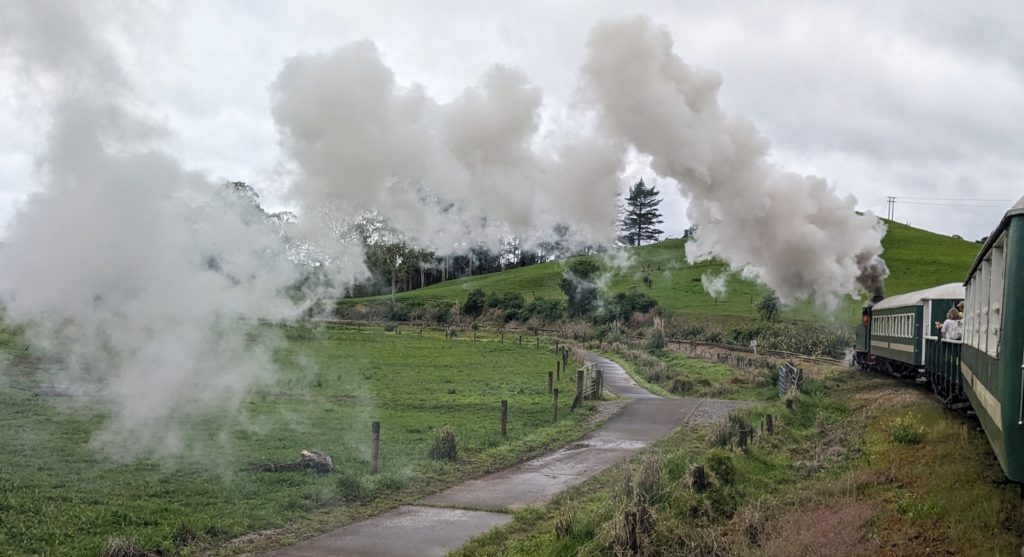
The steam competed with the overcast sky!
We took lots of video and hope to post it soon. When we returned to Kawakawa we learned that it’s not only famous for the Vintage Railway, but also for it’s public toilets, yes toilets! So we had to go see them!

Very eclectic, Gaudi like and whimsical. There is a living roof with grasses and plants growing up top.

Bottle walls brought in colorful light and everything was tiled.
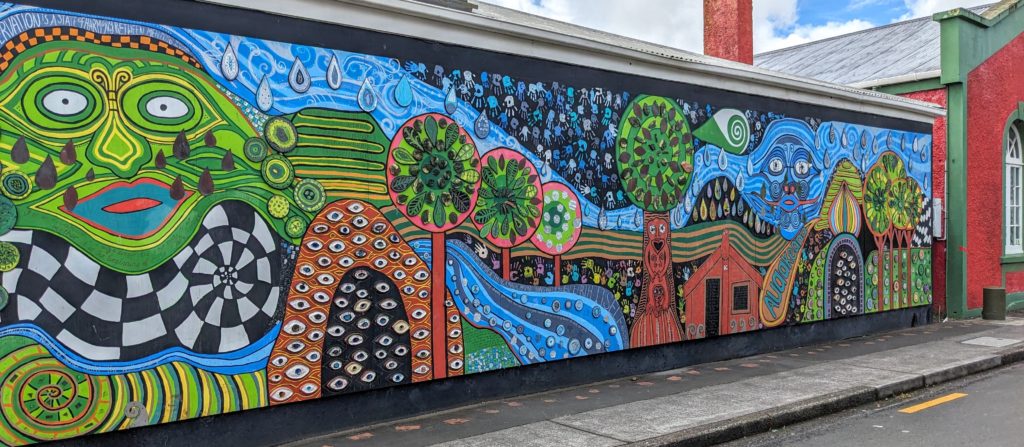
The main street of town had lots of artistic influences, including this mural. Everything had some kind of green swirl, reminiscent of the curled silver fern fronds.
The toilets and mural were designed by Friedensreich Hundertwasser, an Austrian born artist and architect who also worked for environmental protection. He made a nearby NZ farm his home for almost 3 decades, from the 1970’s until his death in 2000.
We still had a half day to fill so we continued our travel west towards the coast which we reached in a little over an hour. The weather changed from finally sunny in Kawakawa to misty, very windy and very overcast as we approached Opononi. We continued until the overlook at the South Head of the inlet to Hokianga Harbour. We walked out to the viewpoint, the old station that warned ships of the treacherous shifting sand bars that guard the harbour’s entrance.

The Tasman Sea on the west coast was stormy today!
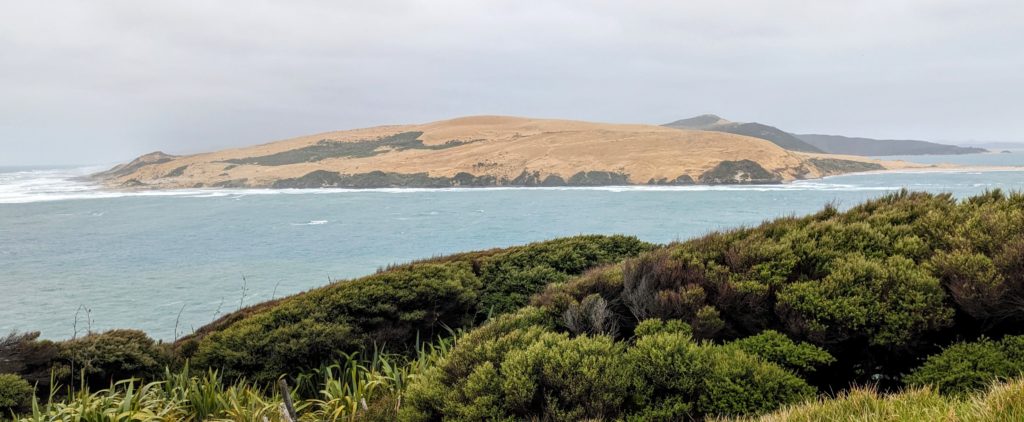
Across the inlet is North Head, covered with huge sand dunes.
We braved the wind for a few more photos then headed north to Rawene where we caught a car ferry across a narrow section of Hokianga Harbour and drove up to Kohukohu. Once a busy town with timber mills and shipbuilding it is now a quaint town that boasts many turn of the century houses built of local kauri wood (now very scarce and carefully protected).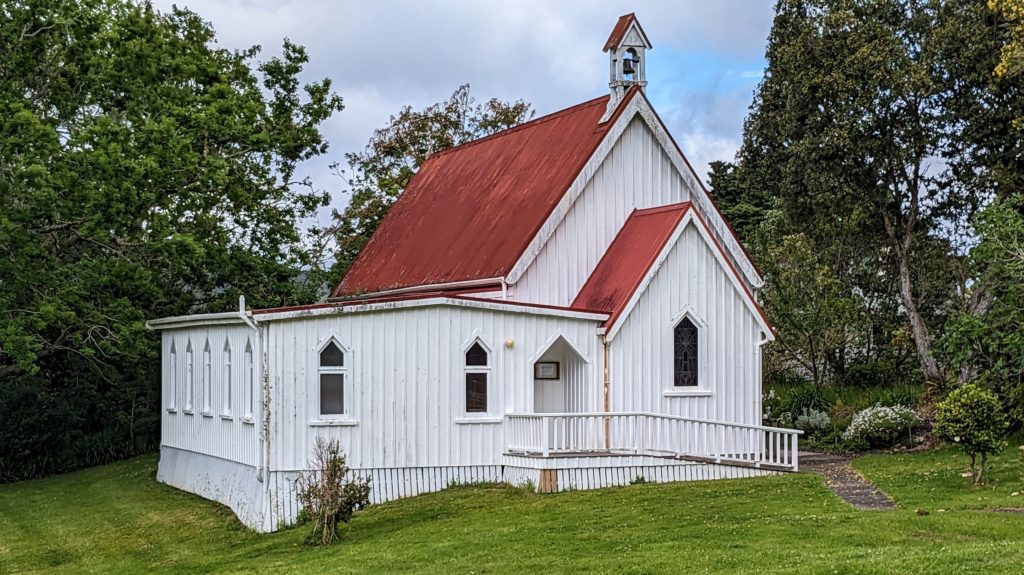
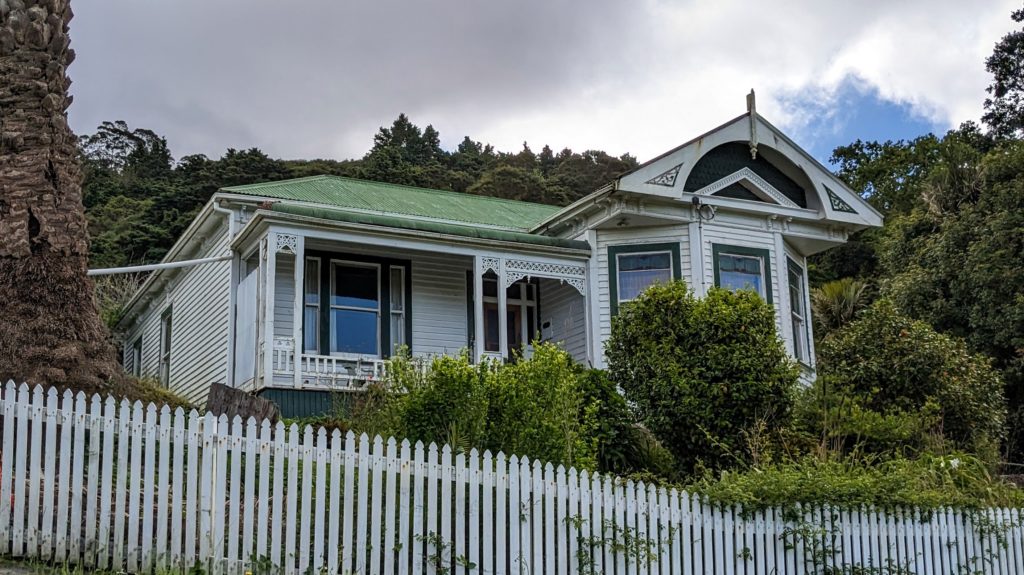
A house above the park where we had a picnic lunch. Notice the filagree decoration on the porch.
We headed home to complete our circular travel. The sun popped through the clouds to illuminate green hills dotted with cattle and sheep. Very bucolic!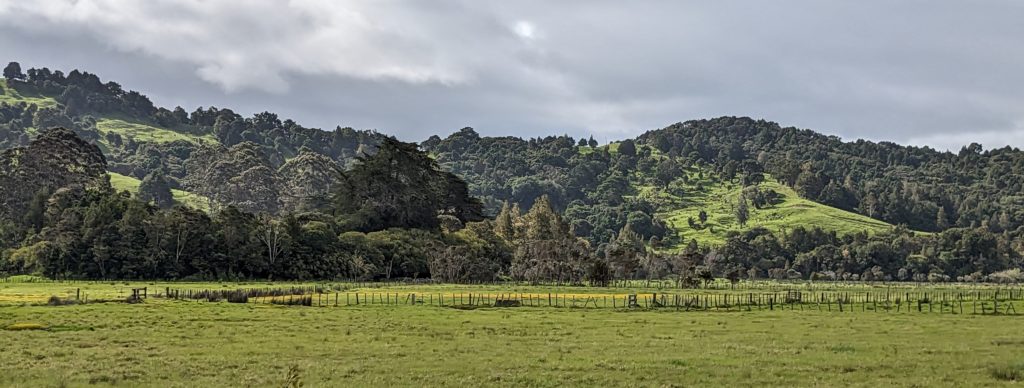
October 20, 2023 Kerikeri (Day 22)
Today the weather finally arrived, off and on rain squalls and lots of wind. We stayed home, warm and dry and caught up on bookwork and webwork! I’ll take you back a few days to our walk along the Kerikeri river and give you some history of the area. Yesterday’s blog about the first mission in New Zealand is joined with today’s about the second mission established in New Zealand, again by Samuel Marsden. This mission was allowed and even requested by Hongi Hika, another Maori chief and uncle of Ruatara. He was the war chief of the Kororipo Pa (fortified hill village) that controlled the Kerikeri inlet nearby the Te Puna inlet controlled by his nephew.
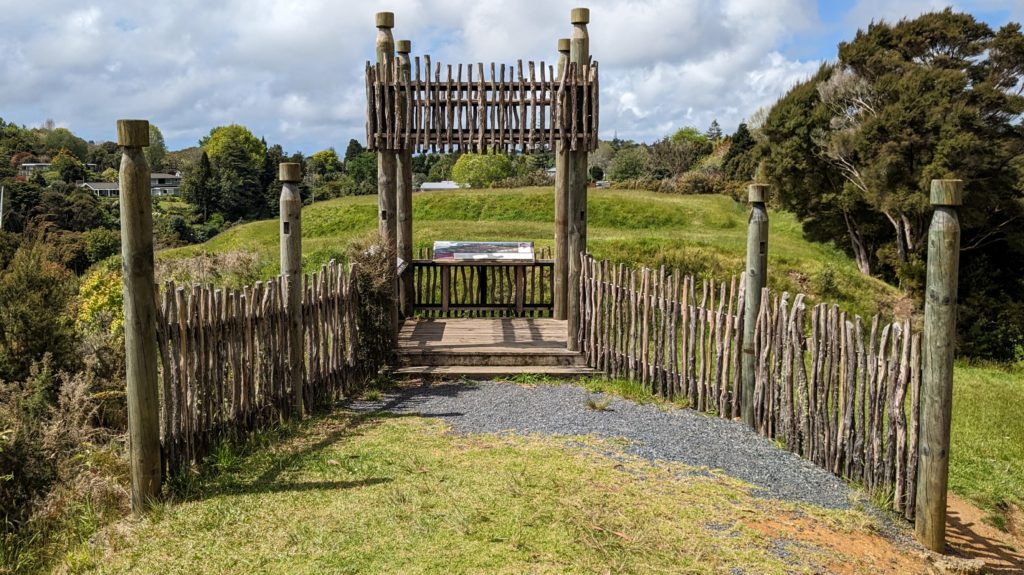
A recreation symbolizing the wooden post fortifications that protected the pa, The terraced hilltop is seen in the background.
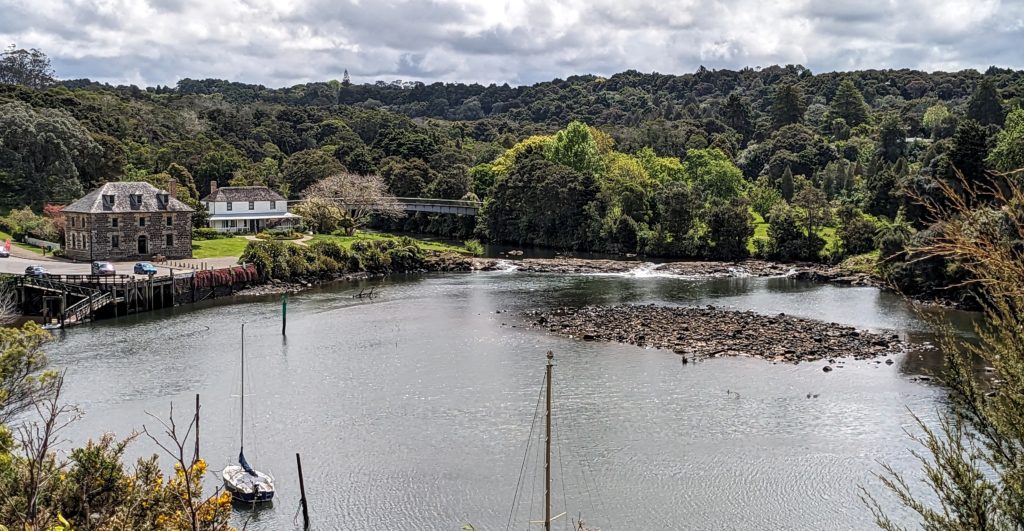
The inlet overlooked and was protected by Kororipo pa. Hongi Hika extended that protection to the mission established in 1822. The Stone Store was built between 1832 to 1836 and has been in continuous use since.

An impressive building!
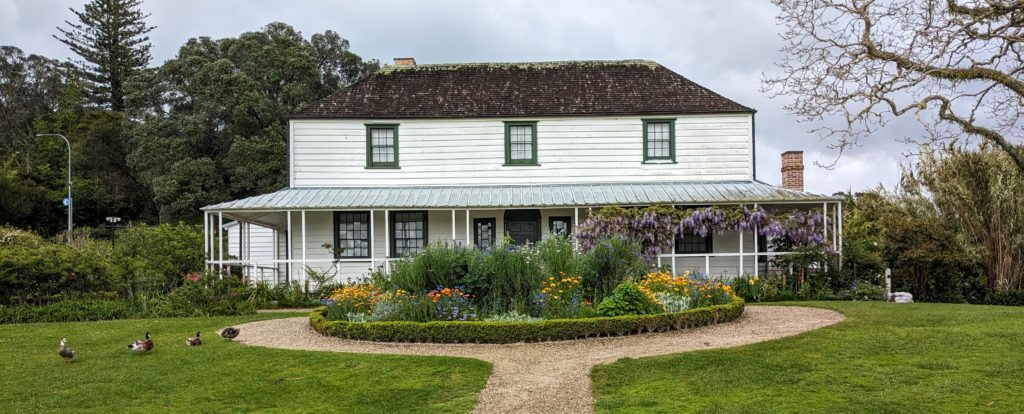
The Kemp House was built to house the missionary John Butler and family. They arrived in 1822, but left the next year after a falling out with Samuel Marsden. Later, missionary James Kemp and his wife & family moved in, eventually buying the property which stayed in the family until 1974 when it was gifted by the family to the NZ Historic Places Trust along with the gardens, orchards and the Stone Store. The house is the oldest surviving building in New Zealand!

We concluded that these benches between the Stone Store and the Kemp House are the oldest surviving benches in New Zealand!
October 19, 2023 Rangihoua Heritage Park (Day 22)
Another iffy day weatherwise, but we decided to go for it and explore the Purerua Peninsula, the north edge of Bay of Islands. Historically important as the first permanent settlement of Europeans in New Zealand-Aotearoa. We were surprised to drive on gravel roads through valleys and hills dotted with sheep and cattle.

Finally, a picture of New Zealand sheep! The white dots on the landscape. We couldn’t get any closer, they run away! This is the first area we have seen that has sheep predominantly. We’ve been seeing more cattle elsewhere.
We continued around the Te Puna inlet, aiming for the tip of the peninsula. The views were amazing! At one spot we could see today’s cruise ship in the bay, ‘The Brilliance of the Seas’.

From this view the cruise ship is hidden by Moturoa island in the left background, which blocks the view towards Russell and Paihia. On the right you can make out the buildings of “The Landing” winery and luxury resort.
We finally reached our destination. This depiction is probably circa 1820’s. The fortified hilltop (or pa) is named Rangihoua and was the home of the prominent chief Ruatara. He was a well traveled man, having signed onto whaling ships in 1805 and had many dealings with Europeans. He had an association with Samuel Marsden, an Englishman in Australia, a member of the CMS (Church Missionary Society) and chaplain to a penal colony in New South Wales, Australia. Their relationship led to the invitation by Ruatara to Marsden to set up a Christian Mission on his lands at the head of Te Puna inlet. After many delays Marsden was able to fulfill his desire to set up the mission in December 1814, “the first planned European settlement where Maori and Europeans learned to live side by side” (according to Tohu Whenua-Landmarks that tell our stories).
This depiction is probably circa 1820’s. The fortified hilltop (or pa) is named Rangihoua and was the home of the prominent chief Ruatara. He was a well traveled man, having signed onto whaling ships in 1805 and had many dealings with Europeans. He had an association with Samuel Marsden, an Englishman in Australia, a member of the CMS (Church Missionary Society) and chaplain to a penal colony in New South Wales, Australia. Their relationship led to the invitation by Ruatara to Marsden to set up a Christian Mission on his lands at the head of Te Puna inlet. After many delays Marsden was able to fulfill his desire to set up the mission in December 1814, “the first planned European settlement where Maori and Europeans learned to live side by side” (according to Tohu Whenua-Landmarks that tell our stories).

The current view. In the time of Maori settlement here the trees would have been removed and the hillside would have been dotted with housing, the terraced hilltop would be palisaded and well protected.
Looking back from the beach, the mission would have been built on terraces for housing, gardens, school house, chapel and utility buildings. Nothing but the terraces remain, with monuments and signage pointing out how life would have been in the early 1800’s here. A huge stone cross marks where the first Christmas Mass in New Zealand was held, two days after the new settlers arrived!

The Marsden Cross marks the spot. A terrace further up the slope is the cemetery of the settlement. Life was hard for the newcomers!

Tensions were common between the Maori (a name they began calling themselves, meaning ‘ordinary people’, after European contact) and the settlers. The Europeans were and still are, called Pakeha, non-Maori. The tensions rose for many reasons but mostly were due to different world-views on property rights and cultural practices.
After our long day we had a wonderful dinner of grilled flounder, again a benefit of our host’s freezer clearing!

A whole small flounder for each of us! And a fresh avocado for the salad and a fresh lemon for the fish, both from her garden!
October 18, 2023 Coastal Walkway Parts 3&4 (Day 21)
This morning I noticed there are ripening artichokes in our hosts front garden!

Artichokes with a bird of paradise in the background.
We decided today is the day to tackle the last 2 sections of the Coastal Walkway that we have not finished. From the Haumi river south to Paihia Road parking area and from the Haumi river north to the town of Paihia. We drove to the broad Haumi river parking area, fronting a big pebble beach that didn’t look too inviting for swimming, and headed south first.

This old tractor was at the edge of private property just yards from the bay.

The track passed through a little, neat & clean campground. Not too full yet.

Imagine waking up to this view out your camper window!

Robert spotted this floating jasmine flower, stuck to spider web maybe?
I wish I could describe the fragrance along most of the trails we have been on! Invasive introduced jasmine is rampant here and Australian frangipani has been introduced as well, among other flowers in profusion. Imagine walking through a perfume department full of tropical flower scents sprayed at you constantly! Sometimes it is overpowering and gives me a headache! We reached Paihia Road and hiked back to the Haumi river parking area. Heading towards Paihia next, we were walking along the bay, on sandy beach or rocks. It seems this route is best at low tide!

Heading to Paihia along the water.

Out in the bay we spotted the Grand Princess, the second cruise ship of the season, with potentially 3,122 passengers, anchored in the bay. From our B&B we can see the tenders bringing the passengers (money) into town. Our host suggested we avoid town on cruise ship days and gave us a list of the boats and their arrival days!
We reached Paihia and got a cappuccino and chai latte to power us back to the car! 4 miles total!
October 17, 2023 Rainbow Falls Track (Day 20)
We went to Kerikeri today to find and walk the Rainbow Falls Track. We discovered a lot of historical points of interest too, but I’ll save that for another day. Rain was predicted and we got a bit of it as we ate our savory muffin and drank our cappuccinos before we started our hike. It sprinkled a little as we walked, but we had our rain jackets at the ready!
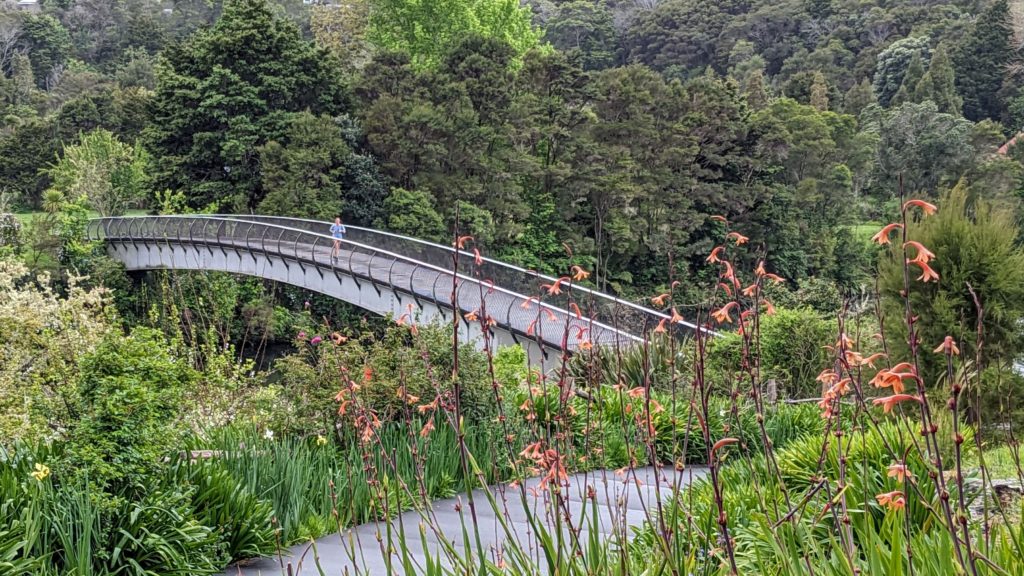
We crossed the footbridge from the historical area into the park where the Kerikeri river track started.

We encountered 2 huge trees covered in burls early on the trail!

The first waterfall, Wharapuke falls, was reached soon after.

The track continued through dark woods full of exotic huge plants, trees and moss covered rock slopes. Going under a highway overpass we saw these black-eyed susan vines, native to east Africa, covering trees and bushes.

Following a raised wooden walkway we finally approached Rainbow falls. Unfortunately the sun was not out so we didn’t experience the rainbow in the mist that it is known for.

The trail then went uphill to give us a view mid-way up the falls.

At the top several observation decks gave us views of the falls from the top.
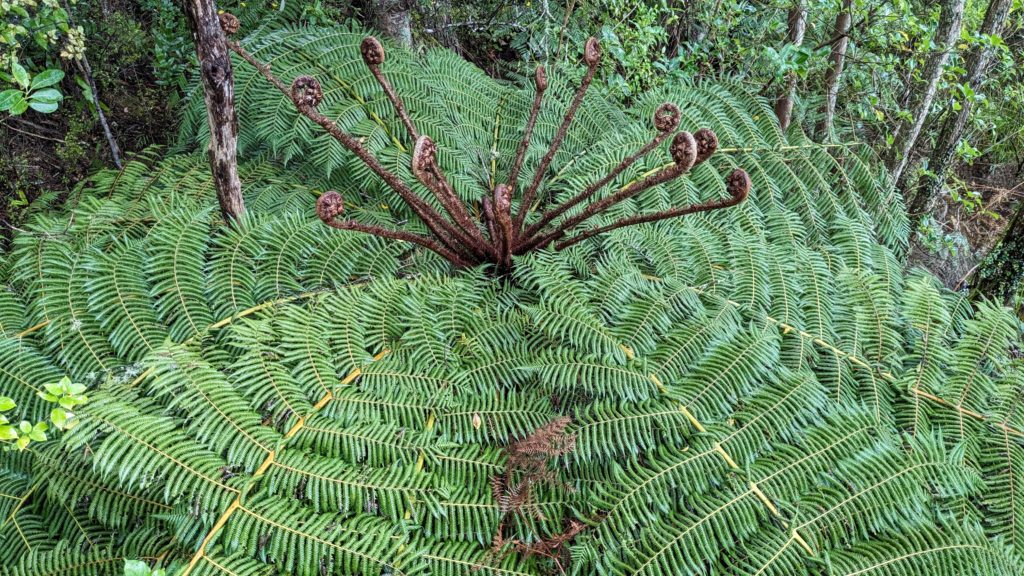
On the left of the deck we looked down at this tree-fern crown, with the new fronds uncurling in the mist from the falls, ready to soak up the sun when it finally comes out!
We retraced our hike back to the parking lot, enjoyed a picnic lunch as the sun came out and dried the grass. In the sun we finished exploring the historical areas, then returned home with a haul of groceries from the bigger store in Kerikeri, the hub of the agricultural community in Northland.


















 This depiction is probably circa 1820’s. The fortified hilltop (or pa) is named Rangihoua and was the home of the prominent chief
This depiction is probably circa 1820’s. The fortified hilltop (or pa) is named Rangihoua and was the home of the prominent chief 

















